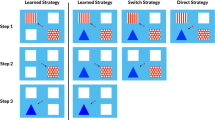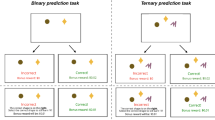Abstract
The conjunction fallacy occurs whenever probability compounds are thought of as more likely than its component probabilities alone. In the experiment we present, subjects chose between simple and compound lotteries after some practice. Depending on the condition, they were given more or less information about the nature of probability compounds. The conjunction fallacy was surprisingly robust. There was, however, a puzzling dissociation between verbal and behavioral learning: verbal responses were sensitive, but actual choices entirely insensitive, to the amount of verbal instructions being provided. This might reflect a dichotomy between implicit and explicit learning. Caution must be exercised in generalizing results from what people say to what people do.
Similar content being viewed by others
References
Abelson, R.P., Leddo, J. and Gross, P.H. (1987), The strength of conjunctive explanations, Personality and Social Psychology Bulletin 13(2), 141–155.
Fantino, E. and Savastano, H. (1996), Humans' responses to novel stimulus compounds and the effects of training, Psychonomic Bulletin and Review 3(2), 204–207.
Fantino, E., Kulik, J., Stolarz-Fantino, S. and Wright, W. (1997), The conjunction fallacy: A test of averaging hypotheses. Psychonomic Bulletin and Review 4(1), 96–101.
Friedman, M. (1953), Essays in Positive Economics. Chicago: Irwin.
Hertwig, R. and Gigerenzer, G. (1999), The ‘conjunction fallacy’ revisited: How intelligent inferences look like reasoning errors, Journal of Behavioral Decision Making 12(4), 275–305.
Hoel, P.G. (1984), An Introduction to Mathematical Statistics. New York, Wiley.
Massaro, D.W. (1994), A pattern recognition account of decision making, Memory and Cognition 22(5), 616–627.
Mellers, B., Hertwig, R. and Kahneman, D. (2001), Dofrequency representations eliminate conjunction effects? An exercise in adversarial collaboration, Psychological Science 12(6), 269–275.
Mulford, M. and Dawes, R.M. (1999), Subadditivity in memory for personal events, Psychological Science 10(1), 47–51.
Shanks, D.R. and St. John, M.F. (1994), Characteristics of dissociable human learning systems, Behavioral and Brain Sciences 17(3), 367–447.
Tversky, A. and Kahneman, D. (1982), Judgements of and by representativeness, In: Kahneman, D. Slovic, P. and Tversky A. (eds.), Judgement Under Uncertainty: Heuristics and Biases. New York: Cambridge University Press.
Tversky, A. and Kahneman, D. (1983), Extensional versus intuitive reasoning: the conjunction fallacy in probability judgement, Psychological Review 90(4), 239–315.
Zizzo, D.J. (2000), Implicit learning of (boundedly) rational behaviour, Behavioral and Brain Sciences 23(5), 700–701.
Zizzo, D.J. (2001), Choices Between Simple and Compound Lotteries: Experimental Evidence and Neural Network Modelling, Discussion Paper no. 57. Department of Economics, Oxford: University of Oxford.
Zizzo, D.J. (2002), Probability Compounding in Words and in Practice. Discussion Paper no. 88. Department of Economics, Oxford: University of Oxford.
Zizzo, D.J., Stolarz-Fantino, S., Wen, J. and Fantino, E. (2000), A violation of the monotonicity axiom: Experimental evidence on the conjunction fallacy, Journal of Economic Behavior and Organization 41(3), 263–276.
Author information
Authors and Affiliations
Rights and permissions
About this article
Cite this article
Zizzo, D.J. Verbal and Behavioral Learning in a Probability Compounding Task. Theory and Decision 54, 287–314 (2003). https://doi.org/10.1023/B:THEO.0000004350.81892.1b
Issue Date:
DOI: https://doi.org/10.1023/B:THEO.0000004350.81892.1b




